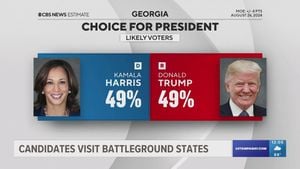With the 2024 election season heating up across the United States, various races have captured the spotlight, particularly for the House of Representatives and state legislatures. Campaign spending tells the tale of eager candidates gearing up to make their mark on what many are calling one of the most contentious political years to date.
Democrats, buoyed by surging enthusiasm from their supporters, are eyeing key races they believe they can flip this November. Particularly, they are focused on House seats where voting trends indicate potential shifts. For example, Vice President Kamala Harris' nomination has fired up Democratic spirits, spurring them to target Republican-held districts where Joe Biden had greater support over Donald Trump during the 2020 elections.
One significant race to watch is Texas, where political landscapes could pivot dramatically based on this November's outcomes. Historically, Republicans have solidified their positions by redrawing district lines, securing their stronghold. Despite this, Democrats argue they have momentum on their side, believing they can snag enough seats to stymie the GOP's push for school vouchers—public funds to pay for private education. This could signal interesting developments as the public navigates both local and national issues.
Beneath these narratives, Governor Greg Abbott’s funds and bold projections suggest Texas Republicans are aiming to leverage heavy voter turnout primarily driven by the Presidential election. Warning of possible shifts, Democratic strategists have pointed to recent victories and promising candidates who may attract voters from their traditionally red districts.
Meanwhile, Republicans are targeting specific Democrat-held seats where recent election dynamics may sway against their opponents. High voter engagement appears likely to benefit GOP candidates like former Uvalde Mayor Don McLaughlin Jr., who has risen to prominence following the Robb Elementary School tragedy. His high name recognition, along with financial backing from platforms like Abbott's campaign, puts him as a formidable contender against Cecilia Castellano, the Democratic nominee.
Beyond Texas, similar stories are playing out across various states, including Maine and Connecticut. For example, scrutiny on spending has shown Republicans significantly outpacing Democrats, especially during final campaigns leading up to elections. The financial aspects can fundamentally alter the chances for candidates as they scramble to connect with constituents.
Utilizing state budgets and aggressive campaign financing, candidates have adapted their strategies to fit the shifting political climate. Armed with diverse fundraising tactics, from grassroots efforts to high-profile endorsements, candidates are bringing varied approaches to courting voters.
Take Connecticut, where Nick Simmons, the Democratic challenger for the 36th Senate District, is making waves by aligning himself with progressives. The race pits him against State Senator Ryan Fazio, who champions moderate viewpoints and capitalizes on his incumbency. Both candidates are determined to speak on matters directly impacting constituents, like the rising cost of living and public safety.
Financing for campaigns is as competitive as the candidates themselves. With both parties scrambling for the same dollar, outside groups have jumped onto the bandwagon, offering their own resources to amplify messages. Some districts are seeing additional cash flow from affiliations and proponents outside the mainstream party machinery.
While these dynamics shape state races, national issues linger, as parties navigate significant debates around school funding, abortion rights, and the handling of economic concerns. It’s noteworthy how these multifaceted areas may substantially impact sway among voters, especially young and first-time voters who show increased interest.
Regionally, races are closely monitored, fostering what could very well result in new shifts within the political hierarchy. Republican-influenced districts, particularly those witnessing demographic changes or younger electorates, may find traditional voting patterns challenged as new issues take precedence over established party loyalties.
Democrats are particularly excited about their competitive positions, citing past successes against expectations. The state’s political pulse appears stronger than ever, with many believing demographic trends favor progressive candidates. While excitement brews, caution exists, framing this as another chapter for Democrats defending hard-fought positions from prior elections.
The stakes remain high for both parties across the board, from small local elections to grand presidential aspirations. Nationally, complex and often emotional subjects tie these local races back to larger narratives gripping the nation. Campaigns are expected to employ innovative messaging, targeting specific issues reflective of constituents’ concerns to capture hearts and ballots.
Some races are predicted to be razor-thin, anxiety-inducing for candidates and voters alike. Given the distinct intricacies of each district, insights point to true battlegrounds determined by who can best align their personal visions with the electorate’s desires.
With voter participation higher than ever, outreach initiatives are transforming engagement strategies previously viewed as cutting-edge. Utilizing technology, candidates are working tirelessly to meet voters where they are, establishing platforms through social media and creating interactive sessions to answer queries directly. This effort seeks to dismantle barriers and distrust, building rapport and enthusiasm across demographics.
Preparations are intensive as the November elections inch closer. With spending trends rising alongside partisan perspectives, these key races—from Senate seats to local representatives—will not only portray immediate outcomes but potentially reshape the political fabric for years to come.
Each party is betting heavily on the minds of voters, and both sides will look to this election to glean marginal gains, seeking not just victory but insight. The narrative remains fluid, marked by the relentless pursuit of influence amid intense competition—a reality encapsulated well within the shifting sands of America’s political arena.
Overall, the 2024 election promises to be not just another race but perhaps one of the most telling moments reflecting American voters' collective mood, priorities, and future direction. With financial warfare on display coupled with authentic dialogues, it embodies the essence of democracy—wherein both hope and uncertainty intertwine.



